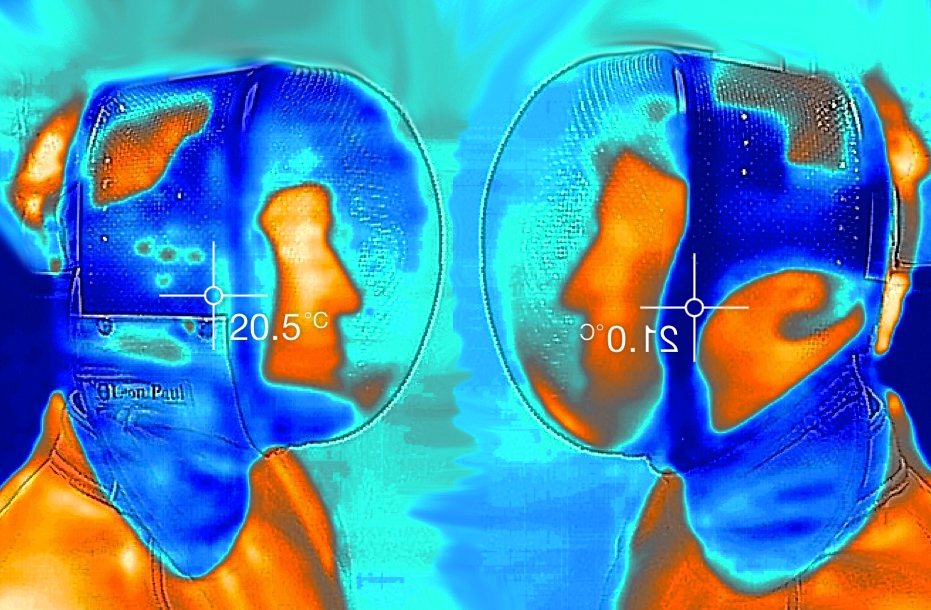We use cookies
Using our site means you agree to the use of cookies and similar technologies. Read about our policy and how to disable them here
You will have frequently experienced coming off the fencing piste dripping in sweat and red in the face. Essentially, when we use our muscles, we use energy. But believe it or not, it is a very inefficient process and only 25% of the energy is used for the muscle to contract and the rest is lost as heat. Our body has several ways to deal with this increase in heat. We tend to have a behavioural response such as take off a layer of clothing as well as a physiological response which increases the blood flow to our skin, which is why your face is very red! We also lose heat through processes called conduction, convection and radiation (you are probably remembering your science at school now). Conduction is the loss of heat when two objects touch – for example if I was to put my hand on a cold surface, heat would travel from my hand to the surface. Convection is the removal of heat due to movement of air or fluid such as blood, again this will move heat from a hotter area to a cooler area. For example, heat will be carried away from the muscles by the blood to a cooler area such as the skin. The air flow you create when you move will then help heat move away from the skin to cool you down. We also lose heat through radiation where heat radiates from nude skin to the atmosphere. As you have realised, when we fence we lose most of the ability to lose heat due to the fencing kit we are wearing from head to toe!! The main area we can lose heat is the head. We can also lose heat through sweat evaporation – have you noticed that fencers tend to be head sweaters? Sweat glands are like muscles, if you train them they tend to get bigger! We produce more fluid as we get fitter and in fencing we increase the amount of sweat in our head/face to enable sweat evaporation to occur so that heat is removed from our body to the atmosphere. I don’t know about you, but the number of times I have run for the tube or a bus and jumped on at the last minute and then like a tap the sweat starts dripping down my face. This is because we have trained those sweat glands!!
What does this mean for fencing?
If we are losing fluid, our blood volume decreases. Therefore, to get the same amount of blood around the body the heart to beat faster and essentially you are working harder to produce the same exercise output. Also, if blood is going to your skin, less blood may end up going to your muscles, again this can make the effort harder. This means you will fatigue quicker, and performance will deteriorate. It is therefore important to replenish your fluids when fencing to prevent this from happening (hydration is really important and I will talk about this another time). Also, you want to try and decrease your temperature during and after fencing. The way clothing is made potentially can help reduce the temperature if it is more breathable. You could ensure you have a cold drink nearby to reduce your body temperature slightly in a break. There are plenty of potential ideas to help reduce your skin and body temperature. One simple method between fights is to take off your jacket. Often, I look around a fencing hall and do not see many fencers with their jackets off. There is always that fear of cooling down too much – but if there is a short amount of time between fights, then cooling is probably important.
What does the research show?

We did a study in epee to see what sort of temperatures we were finding during fencing. Essentially, we found that body temperatures were between 38.5 and 39°C during DE fights. Our body temperature at rest likes to stay around 37°C but when we exercise it can go above this temperature. However, performance starts to suffer when it gets close to 40°C. What we found interesting was the increase in skin temperature. At rest you will usually find skin temperature to be around 32-33°C. However, we were finding skin temperatures closer to 36°C which is quite high. This shows that there is a lot of blood flow going to the skin, but it isn’t helping us cool down much due to all the clothing. We also found that as soon as the fencers stopped fencing it continued to increase for about 10 minutes. This brings us back to the importance of taking the jacket off when the fight is over to help recovery.
Take Home Message
We get hot in fencing! When we get hot our performance can deteriorate. It is important to consider ways to keep your skin and body temperature lower either by wearing more breathable kit, introducing simple cooling strategies such as drinking a cold drink and by taking your jacket off between fights.

